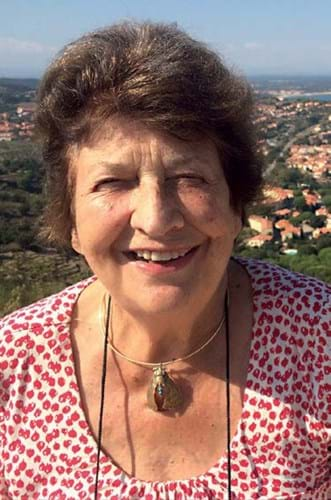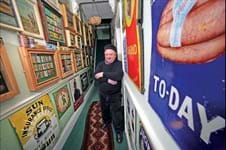Flashback to 1960s Camden. It’s 5.45 a.m. Most of London is still asleep. Dealers in their Volvo Estates start to arrive at Camden Passage Market. It’s already wide awake and bustling with stallholders. Before the dealers even have time to lay out their wares, Victoria and other keen, hardy souls, flashlights at the ready, are rummaging through the boxes, highlighting newspaperwrapped treasures.
Long before eBay or social media were created by Zuckerberg et al, old-fashioned antiques hunters scoured the country for finds, travelling many hundreds of miles in search of precious items to sell on at markets like Camden Passage.
Dedicated shop
Camden was also the birthplace of Rogers de Rin Antiques. In 1963, Tom Rogers, Victoria and her husband David embarked on a journey that took them on to Bermondsey Market, Portobello Market in Notting Hill Gate and in 1970, to a dedicated shop on the Royal Hospital Road in the heart of Chelsea, next door to Gordon Ramsay’s restaurant, a favourite celebrity enclave.
In Collecting an Unruly Passion, Werner Muensterberger identifies why we collect things. ‘To the truly dedicated collector, the “things” they collect have a different meaning and indeed even a potentially captivating force.’ Victoria saw this in connection with collectors of Wemyss Ware, a line of pottery first produced in 1882 by Czech decorator Karel Nekola and Robert Heron, a pottery owner in Fife.
The pottery took its name from the Wemyss family, titled incumbents of Wemyss Castle on the east coast of Fife, who were early and enthusiastic patrons of Nekola and Heron’s ceramic creations.
Victoria was born in Lausanne, Switzerland, in 1931. In 1933 she and her family moved to England. Her father, Nobile Angelo Victor John de Rin Capodistria, a teacher and collector of antiques and antiquarian books, influenced and inspired her at an early age to start her own collection of beautiful things, beginning with English porcelain.
After attending Watford Grammar and a finishing school in Oxford, Victoria began her career in an architect’s office. In her mid-twenties, sensing an opportunity, she persuaded Vivian Fuchs to hire her to create a London-based PR and communications office for the benefit of his planned Trans-Antarctic Expedition. The chief engineer on that expedition of 1957-8, which confirmed Antarctica as a continental landmass and earned Fuchs a knighthood, was Victoria’s future husband, David Pratt, whom she married in 1960. By 1963 they were also partners in the antiques business.
With the 1970 purchase of the Chelsea premises, Victoria developed her passion for Wemyss Ware. She single-handedly built the Wemyss Ware brand in the UK and overseas through relentless networking with her contacts, who included royalty, celebrities and businesspeople. The shop was soon a magnet for a growing number of collectors worldwide. As sole agent for sourcing Wemyss Ware for the late Queen Mother’s collection, Victoria met and formed a lifelong association with Iris Fox, a noted collector based in Edinburgh.
In 1976, she persuaded David Battie of Sotheby’s Belgravia at 19 Motcomb Street, SW1, to stage an exhibition: Wemyss Ware – c.1880-1930. The catalogue listed more than 400 lots with items to suit every pocket, ranging from £5 for a small jug up to £475 for a cat – which today would fetch around £5000. Organised by Victoria and featuring items from the shop, the exhibition was a huge success. Some 10 years later, the Scottish Academic Press published Wemyss Ware; A Decorative Scottish Property, by Victoria in association with the creative team of David Macmillan, Peter Davis and Robert Rankine. The book is itself now a sought-after item.
Wemyss revival
Although there is an ongoing revival of Wemyss Ware, production of classic Wemyss Ware ended in 1957.
In 1980 to mark HM The Queen Mother’s 80th birthday, Rogers de Rin in association with Royal Doulton created a new Wemyss Ware goblet, based on an original made by Robert Heron & Son to honour Queen Victoria’s Diamond Jubilee in 1887. Designed by Alan Carr Linford and Esther Weeks, a limited edition of 500 was manufactured and sold through Thomas Goode & Co of Mayfair. From time to time a few of them pop up at auction, where bidding is brisk.
In 2004, Rogers de Rin became a Royal Warrant holder by appointment to HRH the Prince of Wales, as an antiques dealer and restorer. By 2015 Victoria was ready for semi-retirement. The shop closed in September of that year. Its contents were auctioned off by Dreweatts of Donnington Priory, though Victoria continued to trade and to offer advice to collectors online. At the time of her death she was writing a book to be titled Adventures In The Antiques Trade and working on an idea for a ballet based around Wemyss Ware.
Victoria will be sorely missed by all who knew her, for her caring nature and her passion for antiques and other exquisite things. There was always someone popping into her shop for a drink and a chat about expanding their collection!
Wemyss Ware, both classic and modern, continues to grow in popularity. This is Victoria de Rin’s true legacy.
James de Rin












